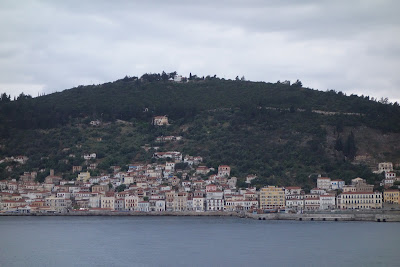After spending the last three ports-of-call in Spain and
Portugal, we’re currently bouncing along in the Atlantic. Waves are cresting in the 15-20’ range with sustained 37 mph winds on the
second day of a five day trek on our way to Bermuda. The ship is rolling and
pitching and rolling and pitching, but that’s okay because the halls are lined
with handrails. Makes typing kind of difficult, however, especially when you
type with two green fingers. Captain says the
weather will be about the same tomorrow. OMG.
I wanted to get back to you for a final post before we sign
off. Looking back over the blogs, the
trip has spanned extreme temperatures, varying geography, cultures, experiences, and over
5,000 years of history. It’s been a lot
of fun and a great way to celebrate our birthdays and anniversary. Soon we’ll have to get back to reality, with
Pat having promised to iron our sheets.
Ha!
The last three ports-of-call were general overviews of the town/countryside
visited. These were interesting, but difficult to describe in any detail. The visits only gave us a taste of what was
there, leaving us wanting more and desiring to come back.
In Portugal, we opted to once again get out of the major
city, Lisbon, and visit the beach and the town of Sintra. Sintra’s prehistoric discoveries date back to
the late Stone Age, but the period of history that most interests me is early
Medieval Times. Get a copy of Rosslyn, Guardian of the Secrets of the Holy
Grail. Rosslyn Chapel, in Edinburgh,
Scotland, is the Templars’ Chapel made famous by “The Da Vinci Code”.
During the 12th Century the Milky Way charted the course for Orthodox Christian pilgrims from all parts of "Europe" towards the southwest and the Cathedral of St. James at Santiago de Compostela, Spain (north of Portugal). This pilgrimage (the "Shell Pilgrimage") continues today.
By contrast the heretical Gnostic Christians (those seeking knowledge, i.e., emerging from the Dark Ages) and those aspiring to be knights made the "Alchemist Pilgrimage," aka the "Pilgrimage of Initiation" (a secret and esoteric pilgrimage) from the Cathedral of St. James at Santiago de Compostela northward through six church and cathedral sites in France (Gaul) to the seventh and final site, Rosslyn Chapel. Each site was designated to teach and award a degree in a single aspect of moral courage, strength, and spiritual transformation. Sintra (first of two photos below) was the purification site and staging area for initial training before starting the pilgrimage.
During the 12th Century the Milky Way charted the course for Orthodox Christian pilgrims from all parts of "Europe" towards the southwest and the Cathedral of St. James at Santiago de Compostela, Spain (north of Portugal). This pilgrimage (the "Shell Pilgrimage") continues today.
By contrast the heretical Gnostic Christians (those seeking knowledge, i.e., emerging from the Dark Ages) and those aspiring to be knights made the "Alchemist Pilgrimage," aka the "Pilgrimage of Initiation" (a secret and esoteric pilgrimage) from the Cathedral of St. James at Santiago de Compostela northward through six church and cathedral sites in France (Gaul) to the seventh and final site, Rosslyn Chapel. Each site was designated to teach and award a degree in a single aspect of moral courage, strength, and spiritual transformation. Sintra (first of two photos below) was the purification site and staging area for initial training before starting the pilgrimage.
Photo from the internet, Chartres Cathedral, the Fourth Degree was awarded only to the initiate who had gained control of his subjective process
so that no unconscious prejudice could rule his action.

Photo from the Internet, Rosslyn Chapel, the Seventh Degree revealing of all of the laws at work within human destiny.
Madeira (Island), Portugal, home of Madeira Wine, was a 7-hour venture around a small, beautiful island.
Its mountainous terrain was about as high as it was wide. Bus drivers maneuvered
their vehicles much like driving a sports car, pretty amazing,albeit scary.
Before we left the mainland, we had the opportunity to visit
Cadiz, Spain.
Chief among our venues was a restaurant with Flamenco
dancers. It promised to be a little Disneyesque,
but it was not. It was a lot of fun.

Pictured above the guitarist was really very good; the singer's voice on the other hand was a cross between an Imam calling the faithful to prayer and Bob Dylan.
Thanks for tuning in. See you next week and maybe on a future blog.
Bill and Pat.
Bill and Pat.
















































